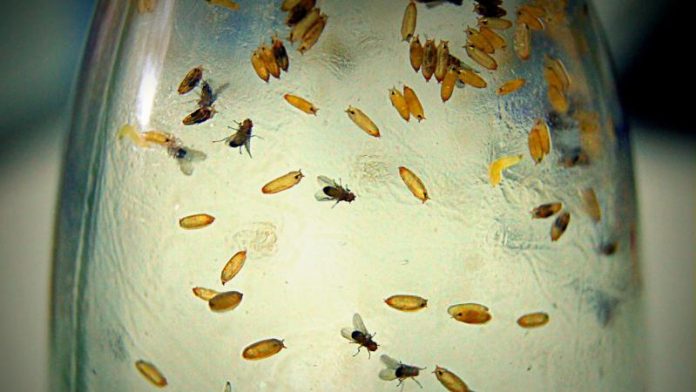The fruit fly is among the most potent research tools in the arsenal of scientists examining the genetic origins of many human illnesses. Hugo Bellen, D.V.M., Ph.D., has been part of a team at the Jan and Dan Duncan Neurological Research Institute (NRI) at Texas Children’s Hospital that has been at the forefront of research into the genes responsible for neurodegenerative diseases in humans. Dr. Bellen spoke with the Examiner on March 30 about the latest discoveries.
The fruit fly, Dr. Bellen states, is an ideal tool for genetic research. The species has been used for research for about 100 years. Its genome was published in 2000. Many fruit fly genes are homologous, similar in structure, to human genes. The University of North Carolina estimates that the insect shares “75% of the genes that cause disease with humans, so scientists can learn about human genetics by studying fruit fly genetics.”
Fruit flies have an average life span of 12 days, Bellen notes. A researcher working with flies can observe genetic changes over generations in a matter of months. In humans, observing the same number of generations could take hundreds of years.
Bellen and his NRI team, including Drs. Michael Wangler and Shinya Yamamoto, induced mutations in fruit flies. After examining almost 35,000 flies, the team discovered 165 genes that were linked to neurodegenerative illnesses in the flies.
The problem then became to demonstrate that the same gene in humans was also linked to such an illness. They began by working with known human genes linked to neurodegenerative illness
Genetics researchers have several methods that allow them to “knock out” a gene from a chromosome and replace it with another. Dr. Bellen said that the NRI team has been able to take normal, non-mutated, fruit flies and “knock out” a specific normal gene which, if mutated, was linked to disease. They could then replace the gene with one from a human with the same neurodegenerative illness. The fruit flies would become ill if the gene mutations were identical, and many did.
Having demonstrated that certain genes were linked to the same neurodegenerative illness in both flies and humans, the NRI team could then look at the genes they discovered in the flies that had not yet been identified as linked to illness in humans. By substituting the human gene for a fruit fly gene, they were able to establish previously unknown genetic links to a number of human illnesses.
Dr. Bellen notes that linking a gene mutation to a specific illness is just the beginning. Additional research is needed to understand how the altered gene affects the normal processes of the human body to produce a neurodegenerative illness. At this point, medication can be tested to determine if the expression of the mutated gene can be stopped or altered and the illness prevented or treated. He cautioned that medication, without a clear understanding of the gene’s expression, is risky since the medication could affect more than just the targeted gene.
In a study titled Fruit Flies in Biomedical Research, the NRI team lays out the existing research and suggests directions for additional work. Dr. Bellen stressed that funding for this research has been severely cut by the Federal Government. Funding for fruit fly research has dropped by about 25 percent in the last five years.
Bellen calls the work of his team “basic research.” The loss of funding at this level translates to an even more significant cut to research at the patient level.
The World Health Organization estimates that the rate of diseases causes by a single gene defect may be as low as one out of every 100 births. The National Human Genome Research Institute (NHGRI) lists several dozen human illnesses with a genetic component.















